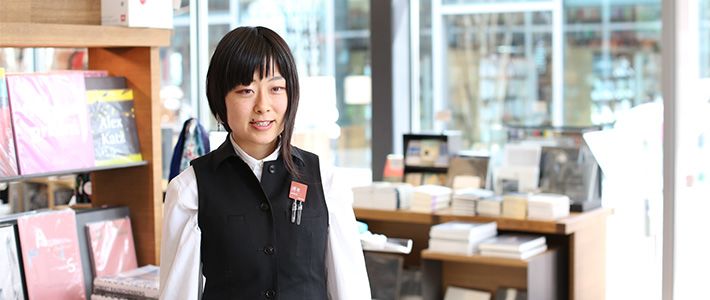
Shimizu Harumi: A Concierge of Photo Books at Daikanyama Tsutaya Books
Culture- English
- 日本語
- 简体字
- 繁體字
- Français
- Español
- العربية
- Русский
Japanese Photo Texts Attract Global Interest
Shimizu Harumi began working at Daikanyama Tsutaya Books in March 2014, where she is now in charge of the photography book section. “Since we opened in 2011, we’ve been proud to offer one of the largest collections of photo books in Japan. This is why I wanted to work here,” she says. “My previous involvement with photographs was as an assistant to a photographer. I’ve come into contact with many photo books here, making me realize how limited my knowledge was about photography.”
Daikanyama Tsutaya Books is a good place for observing photographic trends in Japan and in the world. Shimizu observes: “I think these trends grow out of certain national sensibilities, which in Japan appears as a tendency toward personal and private photographs. You don’t find major differences between nations in such broad categories of photography as snapshots or documentary photographs, but the background to such work and the originality revealed can be quite different. Once you become aware of this, photographs have so much more to offer.”
Foreign customers at this flagship Tsutaya branch are increasing year by year, and many who come to the bookstore are fans of Japanese photography with a considerable awareness of these differences, says Shimizu. The shop’s presence on the cultural scene is such that sightseeing tours make their way through its doors. Of course, the bookstore also has many individual customers, many of whom become repeat visitors.
A Bookstore for Photography Aficionados
What foreign customers are interested in depends on how well they know Japanese photography, notes Shimizu. “Those with a casual acquaintance will often ask for the works of Araki Nobuyoshi or Moriyama Daidō. Meanwhile, a growing number of better-informed shoppers ask for arcane and hard-to-get photo books—even some that have just been published—or for vintage photo books.” Which photographers do these knowledgeable buyers request? “They include Narahara Ikkō, Shibata Toshio, and Hamaya Hiroshi. There are also many inquiries about Fukase Masahisa now that his photography books are being republished. Miraichan [Future girl] by Kawashima Kotori, with its cute photographs featuring a Japanese sensibility, is also moving well as a gift item.”
Daikanyama, where the bookstore is located, is a district home to numerous fashionable apparel and variety stores. Given this neighborhood association with fashion, the shop’s offerings related to fashion and design are also popular. Topical photo books, such as those related to exhibitions or movies, also move well. “When movies about photographers are playing, like The Salt of the Earth or Finding Vivian Maier, there’s a lot of interest in related photography books,” says Shimizu. “I aim to stock photography books as best I can for such topical subjects as well as for the hardcore fans of these collections.”
Quality Books Generate Constant Sales
The appearance of electronic books and weak sales for physical products are creating a difficult environment for the publication industry. Even so, notes Shimizu, “I remain passionate about communicating the appeal of physical books. One way we do this is through a book design exhibition we hold each year. This exhibition highlights the different ways books appeal from their content to their paper quality, design, and how they are edited.” Tsutaya employees discuss the many books they handle each day to select those that left a strong impression during the year for the exhibition.
“When a book sells, we analyze the reasons for the sale. Was it because of price, design, or content? What I can say for certain is that the quality photography books we recommend generate constant sales.”
Books are attractive as physical objects, explains Shimizu. They are more than just vehicles for information. “When their content and design are well matched, the photography books you hold in your hands can offer truly rewarding experiences,” says Shimizu. “These titles have a real presence. These are the books that I want to introduce as a person in this business.”
(Originally published in Japanese on July 26, 2017. Text by Matsumoto Tomoki. Photos by Takahashi Munemasa.)
